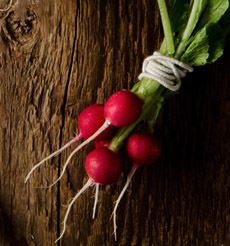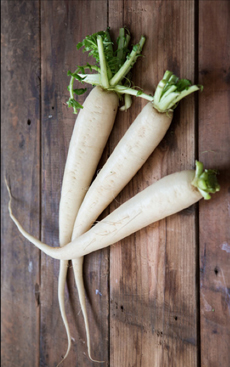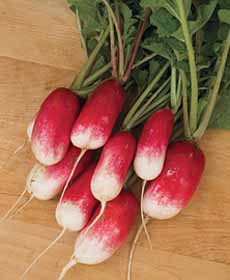TIP OF THE DAY: Types Of Radishes & Ways To Use Radishes
|
Low in calories, high in crunch, often with a hot pepper spiciness, radishes (Raphanus sativus) can be a fun food. They’re nutritious*, too. If you’re old enough, you may remember the time when radish “roses” were almost as common a plate garnish a sprig of parsley. You sliced the rose in a certain way (or used a radish cutter), then dropped the radish into cold water, where the slices opened up into “petals.” As a child, we ate them petal by petal. There are numerous varieties of radish beyond the red globe “supermarket radish,” known as the Cherry Belle. Different varieties have varying levels of heat-spiciness, mostly depending on growing conditions. Even within a particular variety, it can vary based on soil, water, hot vs. cold weather, early versus late harvest and other factors. Some people like them hot, others not so much. Unfortunately, you have to sample one to know what you’ve got. The wild radish may have originated somewhere in southeast Asia, and developed by farmers in central Asia, China and India. Radishes enter the written record in the third century B.C.E. and appear in Greek and Roman texts in the 1st century C.E., which describe small, large, round, long, mild and sharp varieties. The name comes from the Latin word “radix,” which means “root.” The radish was one of the earliest vegetables to be brought over from Europe (source). Burpee currently sells 30 varieties of differing shapes, sizes and colors. Breakfast This recipe from Natasha’s Kitchen is a Ukranian influence. The sour cream dressing helps to neutralizes the pungency of the radishes. Easy to make, prep time is just 10 minutes. It goes very nicely with grilled meats and anyplace you’d serve cole slaw. Ingredients For 6 Side Servings |
|
|
|
Preparation 1. COMBINE the cucumbers, radishes, bell pepper and green onion in a medium salad bowl. 2. COMBINE the sour cream, dill and salt in a small bowl. 3. STIR the sour cream dressing into the salad just before serving. If the radish leaves are fresh and sprightly, consider leaving them on. They’re edible and pretty (photo #3). In fact, the leaves are the most nutritious part of the plant. They have a very mild flavor, like lettuce. There are many varieties of radish, but here are the key ones to look for in markets: Black Spanish Radish: The spiciest radish, and the one that looks least like a radish (photo #2). It can be pickled or grated like horseradish. Cherry Belle Radish: The red, round supermarket radish (photo #1). Slice thin and toss into salads or onto tacos. Daikon Radish: This long, white Japanese radish looks more like a parsnip than a radish (photo #3). A mild radish, it can be used any way. It’s shape enables it to be shredded garnish as a garnish or a base, as it’s used with sashimi. Easter Egg Radish: So called because they come in a variety of colors, like easter eggs: pink, purple, red, and white (photo #4). They are similar in taste and texture to the basic Cherry Belle radish. French Breakfast Radish: They’re small and mild in flavor, which is why you can eat them for breakfast (photo #5). French people enjoy them with sweet butter. You can also roast them. Watermelon Radish: More mild in flavor but vivid in color—green and rose, similar to the colors of the watermelon for which it is named (photo #6). Slice it thin for salads or garnishes, cut them a bit thicker for crudités. You can pickle them, too.
|
||





